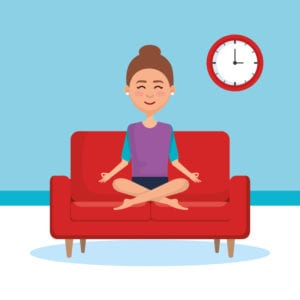Calm In The Chaos of COVID-19
As the Covid-19 pandemic continues with changes to the way we have to live, the very unfamiliar ways we are expected to adapt to can feel strange and overwhelming. We may often find ourselves swinging between chaos and calm. This isn’t surprising when you consider the impact the change has upon us all
In these unprecedented times the goal posts are shifting almost every day, and before we have a chance to get our head around today’s changes and reach a calmness, we are hit with another wave of change which sends our heads into chaos again.
It’s like a game of snakes and ladders, just as you make some progress, you find yourself sliding down a snake. Fear, anxiety, anger and frustration can overwhelm us as we search to understand the new way of living with the reality of social distancing, lockdown, home-schooling and the financial changes. When you add to this the fear of threat to our own health we may feel trapped in our emotional chaos.
How do we keep our anxiety levels from ricocheting and sending us into emotional chaos?
Perspective – understand your fears
Acknowledge your fears, i.e anxious, scared, frustrated, angry etc., these are valid feelings. Write them down and see if you can identify what is surrounding that particular emotion.
Then divide into two parts, those you have some control over and those that you don’t. Solvable worries that may be addressed to all or some extent and unsolvable worries, those that can’t be addressed .
For example – Im not sleeping well because I’m angry about what’s happening with Covid 19. This to some extend is a solvable worry.
Rate the worry on a 1 -10 scale.
Try writing about your anger. Find a safe place or way to display your anger i.e shout out loud what you’d like to say to the Coronavirus, take a pillow and a wooden spoon and release the stress by hitting the pillow ( or any safe soft object).
Does this change your rating?
‘I’m anxious about how many people are dying’, this is an unsolvable worry that we have no individual control over.
Rate the worry on a 1 – 10 scale.
Then ask yourself what you are doing to help, ask yourself if you are making a difference i.e following all government guidelines, washing hands, staying inside etc.
Does this change your rating?
Scoring can give you a sense of perspective.
Planning
When we feel chaotic, we feel threatened and our natural response to this is fight, flight or freeze. Planning helps confront these feelings by doing something practical.
Concentrate on your solvable worries, remember you may not be able to totally resolve the worry. Reflect on what you have written down and challenge that thinking.
You may have been ruminating and have a series of ‘what if’ scenarios whirring around your head. Rather than let this continue, because there is always a never ending list of what ifs which will keep you stuck in the anxious state, start taking positive, logical action where you can.
Think about what practical options there may be to your anxiety. So if you’re thinking ‘What if I don’t get paid for six months?’
1 – work on a financial plan, work out your current out goings
2 – How can you cut down spending by reducing outgoings, cancelling subscriptions or taking payment holidays?
3 – What will you save during lockdown by not travelling, grabbing takeout coffees, eating out and socialising?
4 – What financial help is available to you externally?
Logically tackling the problem enables you to regain some sense of control and will hopefully bring down the score on your scale, so try re scoring and see if there is change.
Breathing – mindfulness
‘Oh yes here we go’ I hear you say! But getting in tune with our breathing and being present in the moment really can help to calm us.
When we experience chaos, as said we perceive a threat to our emotional wellbeing which puts our whole system under stress which increases the stress hormone, cortisol, in the body.
We need to send a signal to our brain that ‘we are ok’ to counteract this even if it feels untrue and breathing techniques can send these signals very effectively and provide you with temporary calmness at least.

1 – Take a deep breath in through your nose for four seconds
2 – Hold for four seconds
3 – Release through your mouth for ten seconds
4 – Repeat several times.
Getting in tune with your breathing disconnects your thinking from your worries as you concentrate on the counting. With practice you will no longer need to count and you may find your mind wandering back to thinking, if so gently bring your awareness back to the breathing. Laying a hand on your chest or stomach can help this as you feel the rise and fall of the area. This may be put into practice at any time of the day to regulate your breathing especially when feeling overwhelmed.
Remember your normal
Please try to remember what is still normal in your life. In times of change and uncertainty it is very easy to loose sight of the things that have stayed the same. Take some time to think of these and make a list if you can, this you can refer to as a constant reminder when struggling. Recognising what is normal and has not changed will help ground you to what is familiar which , in turn, will help with anxiety levels
Ultimately, whilst our situation at the moment is very tough, unfamiliar and can be scary, remind yourself that it will pass. You could put signs up around the house or in your bedroom as a constant positive message:
IT WILL PASS, IT WILL END and you will have conquered one of the most challenging times of your life!
Written by June Whitehead

